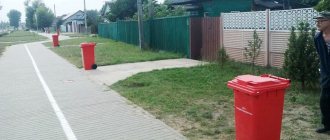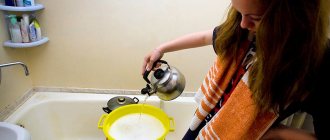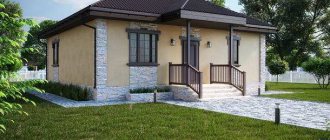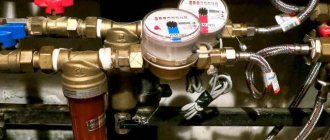In the vast majority of cases, a private developer independently arranges water supply, sewerage and sewerage systems. The receiver of dirty waste is a septic tank, which is made of concrete rings. It can also be made in the form of a pit, lined with bricks and coated with clay. More practical owners set up a septic tank using special sealed containers that ensure the cleanliness of the environment. But even in this case, they are obliged to comply with the rules for the location of such devices. All these rules are regulated by the Federal Law of March 30, 1999 N 52-FZ “On the sanitary and epidemiological welfare of the population” and the Code of Rules SP 30-102 - 99 “Planning and development of low-rise housing construction areas.” All these sanitary standards for private homes are subject to mandatory compliance.
The frequency of wet cleaning in apartment buildings is set by the owners at general meetings or by the developer
In clause 8.2 of the MR Rospotrebnadzor elaborated on determining the frequency of wet cleaning of floors in common areas of apartment buildings. Clause 126 of SanPiN 2.1.3684-21 states that this should be done using detergents and cleaning products daily. But in the MR, the department noted that the frequency of cleaning must comply with housing legislation.
The frequency of provision of services and performance of work for the proper maintenance of common property in the apartment building is determined and reflected in:
- OSS decision during direct management of the house;
- management agreement with the management company;
- in the manner specified in the Charter of the HOA or cooperative;
- agreement for the provision of services and performance of work on the maintenance and repair of common property in accordance with Part 1.1 of Art. 164 Housing Code of the Russian Federation;
- decision of the developer in the case provided for in Part 14 of Art. 161 Housing Code of the Russian Federation.
When carrying out sanitary and epidemiological supervision of the maintenance of common areas of MKD, Rospotrebnadzor recommended taking into account the requirements of housing legislation for the frequency of wet cleaning in houses.
On new rules for creating and recording waste collection sites
1726482
Allowable distances
SNiP defines the minimum distance from structures to the foundation as 5 m. However, this requirement applies primarily to filtration wells or fields. The sealed receiving tank may be located closer to the house. But even in this case, there remains the danger of wastewater leaking into the ground. Pipe connections sometimes come apart. Mechanical loads or soil movements can destroy pipes. Therefore, you should not take risks and install the container close to the walls.
For cesspools, the distance must correspond to standard values. This is prescribed by sanitary standards for the sewage system of a private house. The tanks emit an unpleasant odor and the waste releases harmful gases. Failure to comply with the requirements may result in unbearable living conditions. In addition, there is a danger of the spread of infections and biogas poisoning.
In addition to the distance to home, it is important to meet other requirements. The location of the sewerage system on the site according to SNiP requires that:
- from the septic tank to the border of the site (neighbors’ fence) must be at least 2 m;
- the distance to the garden (planting area) should be 3 m or more;
- it is necessary to provide a distance of at least 30 m to the water intake site (well, drinking well). If the site has loose sandy soil, the norm increases to 50 m;
- to a river or stream - 10 m;
- the nearest body of water - at least 50 m;
- to the road (roadway) - 5 m.
The design standards for sewerage in a private house are primarily designed to ensure comfortable living for people. The second task is to preserve the structures of buildings. In addition, it is important to create normal conditions for plant growth and eliminate any influence of the external part of the system on neighbors. If violations are committed during the construction of the sewerage system, the owner will have to bear the appropriate punishment. This may be financial, administrative or even criminal liability. Ill-considered actions are fraught with undesirable consequences, so it is important to carefully follow all the requirements of regulatory documents.
When building an autonomous system in a private house, you will need to coordinate the project with the BTI. If this is not done, the construction will be considered illegal. When the presence of an unapproved structure is discovered, you will have to pay a fine and register the system. In some cases it may be forced to be demolished.
Property managers should develop a water quality and safety program
According to clause 78 of SanPiN 2.1.3684-21, management organizations must conduct production control of the quality of drinking and hot water. As noted by the Head of the P1 Association, Elena Shereshovets, after eliminating accidents on the in-house engineering networks of the house, the management authority must flush and disinfect the water supply system with mandatory laboratory control of water quality and safety (clause 82 of SanPin 2.1.3684-21).
Rospotrebnadzor in clause 4.7 of the MR indicated that individual entrepreneurs and legal entities operating water supply systems must develop a program for industrial control of the quality and safety of drinking water. Such a program should indicate:
- a list of controlled indicators of drinking water quality and their hygienic standards;
- methods for determining indicators;
- a plan of water sampling points at water intake points, before supplying water to the water supply distribution network and at the point closest to the boundary of the operational responsibility of the house;
- the number of controlled water samples and the frequency of their collection for laboratory research, for each sampling point;
- calendar schedules for water sampling and testing.
The number of controlled water samples and the frequency of their collection are determined for each water supply system individually and are indicated in Appendix 2 to SanPiN 2.1.3684-21.
Why recommendations of the Ministry of Construction of the Russian Federation cannot violate the rights of residents of apartment buildings
34260
Conditions for placement of receiving tanks
It is best to install a cesspool, septic tank or other receiving device in an area with soft soil. It does not create difficulties when performing excavation work. However, the home owner does not have to choose. If there is a high groundwater level, it is necessary to ensure the maximum possible distance from the septic tank to buildings and drinking wells. This is important, since drainage may break into the ground.
When choosing a location for a septic tank, you should first consider the lowest points of the site. This will reduce the amount of excavation work. In addition, it will be easier to ensure the slope of the pipelines.
An important point is the possibility of access of special equipment. From time to time, the septic tank will have to be cleaned of accumulated waste.
If the sewer truck cannot fit, you will have to do the work manually.
When drawing up a plan for the placement of a septic tank, it is necessary to draw a drawing of the site to scale. It must indicate all buildings, structures, and communications. This will allow you to more correctly determine the optimal location for the septic tank.
You may also like:
Sewage pipelines made of high-density polyethylene pipes with sleeves with a diameter of 110 mm: technology and features
Slope of sewer pipes according to SNiP
Recommendations are non-binding, but MAs must comply with the requirements of SanPin 2.1.3685-21
In pp. 8.2–8.4 MR lists several more interesting recommendations from Rospotrebnadzor for house managers:
- When assessing the noise level in residential premises, the standards from paragraphs are applied. 100, 104 SanPiN 2.1.3685-21 “Hygienic standards and requirements for ensuring the safety and (or) harmlessness of environmental factors to humans.”
- Deratization and disinfestation in common areas of apartment buildings is carried out by management entities, homeowners' associations or cooperatives, and in the premises of apartment buildings - by their owners.
- In accordance with clause 133 of SanPiN 2.1.3684-21, littering, pollution and flooding of basements and technical underground areas, staircases and cages, and attic spaces in apartment buildings are not allowed.
Let us note that the recommendations of any ministries and departments, including Rospotrebnadzor, are not regulatory legal acts and do not contain binding rules of conduct. As the Supreme Court of the Russian Federation noted, they are advisory in nature. But at the same time, the management must comply with the norms of SanPiN 2.1.3684-21 - these are mandatory requirements for house managers (Part 1.1 of Article 161 of the Housing Code of the Russian Federation).
How to do this correctly, Elena Shereshovets, Head of the P1 Association, told us. She released a series of videos with their explanations for management organizations, homeowners associations and cooperatives:
- in the field of MSW management;
- on water quality control and cleaning in apartment buildings;
- explanations of Rospotrebnadzor on its multiplicity;
- How to convince building residents to raise their rent to meet new requirements.
We hope that they will be useful to you in meeting the mandatory requirements of the new SanPiN 2.1.3684-21.
Responsibility for violation of sanitary standards
If sanitary standards for private houses are violated, administrative liability is provided for this. If there are disagreements with your neighbors regarding the incorrect location of sanitation and hygiene facilities or utility and other buildings from your point of view, you can first submit an application to the District Administration with a request to resolve this issue. If such intervention does not help, then you can safely go to court with a statement of claim, in which you should indicate which parameters of the location of objects were violated. As an evidence base, you can use a plan of the site and buildings on it, with the obligatory indication of boundaries and distances. You can also order a copy of the technical passport of the neighboring plot from the BTI.
Since the trial is a very lengthy process, in order to take quicker measures, you can contact the prosecutor’s office with a request to check the location of buildings and sewer systems on your neighbors’ property for compliance with federal law. This measure is most effective if you have evidence of harm caused by violation of sanitary standards by unscrupulous neighbors. This could be an analysis of drinking water, photos of obvious drains from a neighboring area, and other facts according to the circumstances of the case.
Types of models
When planning to create a sewer system in a house, it is necessary to immediately design a local treatment system. It is important to position the septic tank correctly so that all standards are met and met. It is necessary to calculate the volume of wastewater and select the appropriate VOC design.
Close-up
For a summer house with temporary accommodation for up to 4 people and a shower in the bathroom, a single-chamber sump tank with a bulk bottom is suitable. Filtration will be carried out through it and some of the water will come out. It will be enough to pump out the contents from it once a season.
On loose soils with groundwater close to the surface, a tank with a solid bottom or concrete rings stacked on top of each other with a cushion at the bottom will be optimal. Under them you need to dig a hole 4 m deep with a layer of clay below. You will have to pump out water from such a waste collector more often, once every 3–5 months, but there will be a guarantee that the water in the well will not become contaminated.
For a house with a bathroom and several sinks, a kitchen sink and other equipment, a model with an overflow and biological water purification or disposal through an aeration field is required. The water at the output of such a device can be used as technical water: to water the garden, wash the car, paths and the facade of the house. Maintenance frequency – sludge cleaning 1–2 times a year.
Installation in the village
The common village latrine and cesspool belong to another category of disposal devices. The distance to it from the fence according to SNiP is much greater.
Types of toilets provided for use
The problem of developing compact hygienic devices has become very acute for construction firms and enterprises, which are interested in the increased demand for modern hygienic facilities.
In a standard-sized dacha, it is extremely difficult to comply with the requirements stipulated by SNiP or sanitary standards.
Standards for SNT and individual housing construction
Often, these norms for the distances at which a toilet and a source of drinking water, a sump tank or a water intake device can be placed are simply not feasible. Therefore, types of street toilets with a developed system of epidemiological and environmental safety appeared.
The distance from the toilet to the neighbor’s fence is the norm of SNiP and SanPiN, which additionally does not require any constructive solutions when building an outdoor bathroom. Most people in the country limit themselves to building a standard “birdhouse” made of wood, sometimes even equipped with a toilet and additional amenities.
In a village or rural area, where the adjacent area differs from the dacha plot in size, it can calmly stand for the time necessary for operation, and then the hole is buried and the latrine is moved to another place.
Distance from the fence according to SanPiN and SNiP standards
Building a “birdhouse” at your dacha is cheap and cheerful, and this is by no means the worst way out of the situation. With a properly designed capacity, it can last for ten years, especially if it is used only during the season and by a small number of residents.
However, if it is necessary to move it to another place, understandable difficulties arise with the question of where it can be placed. Most often, precisely because neighboring areas with their own clearly equipped infrastructure are closely located around.
Separate standards
SanPiN 42-128-4690-88 allows you to calculate the required number of special containers for waste: how many of them should be located in a certain area. The basis for calculations is the population size in a particular segment and the accumulation rates of various types of waste.
Canopy over trash can
On private territory, the distance from the house to the containers, especially in SNT, where the area of the site is limited, the owner can reduce to 8 m by written agreement with neighbors or the board of the gardening partnership.
Requirements for kindergartens
For kindergartens, a separate SanPiN 2.4.1.3049 13 is used.
This act establishes requirements for:
- the location of the garden building;
- design and maintenance of the territory adjacent to the preschool educational institution;
- equipment of premises;
- organizing a ventilation and water supply system for gardens;
- reception of children;
- personal hygiene of workers;
- catering arrangements.
Preschool groups, after making changes, may provide for higher temperatures compared to what rules were in place previously. At present, no clear restrictions are being introduced.
Thus, to maintain the condition of the apartment building, it is necessary to use established rules affecting air exchange, heating, and water supply. Failure to comply with these provisions can lead to the formation of mold and the destruction of the house.








